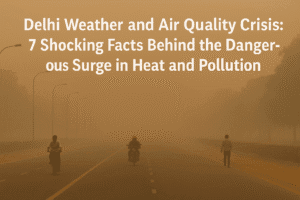Delhi Weather and Air Quality Crisis: 7 Shocking Facts Behind the Dangerous Surge in Heat and Pollution
Delhi’s weather swung dramatically this week as scorching daytime temperatures of 42.3°C gave way to thunderstorms and gusty winds, triggered by a convective system moving from Rohtak. While the rain offered fleeting relief, air quality remained “poor” (AQI 278), with PM10 levels in areas like Wazirpur hitting 847 µg/m³—eight times the safe limit—due to dust-laden winds from Rajasthan and Pakistan.
Authorities enforced Stage 1 of pollution curbs (GRAP), halting large-scale construction and intensifying dust control, but variable winds delayed improvements. The IMD predicts gradual air quality recovery from May 18, alongside cooler temperatures (25–38°C) and possible rain later next week. Meanwhile, peak power demand surged to 6,867 MW amid heat stress, nearing Delhi’s seasonal records. Residents face dual health risks from pollution and heat, underscoring the urgency for sustained emission controls and adaptive urban planning to counter recurring environmental crises in the capital.

Delhi Weather and Air Quality Crisis: 7 Shocking Facts Behind the Dangerous Surge in Heat and Pollution
Delhi’s recent weather and air quality fluctuations highlight the city’s ongoing struggle with environmental and climatic pressures. Over the past week, residents experienced a mix of extreme heat, sudden thunderstorms, and persistently poor air quality, underscoring the complex interplay of natural and human-driven factors.
Weather Whiplash: From Scorching Heat to Thunderstorms
On Friday, May 16, 2025, Delhi recorded a maximum temperature of 42.3°C, nearly two degrees above seasonal norms, while nighttime temperatures hovered around 26.2°C. However, relief arrived unexpectedly as convective systems—localized weather phenomena driven by rising warm, moist air—triggered thunderstorms and gusty winds (40–50 kmph). These storms, originating in Rohtak and moving southeast, brought scattered rainfall across Delhi-NCR. Areas like Ayanagar received 7.2 mm of rain, while Safdarjung, the city’s baseline weather station, logged 1.4 mm.
The abrupt shift temporarily eased the heat but did little to mitigate air pollution, with PM10 (coarse particles) and PM2.5 (fine particles) levels remaining alarmingly high. For instance, Wazirpur’s PM10 spiked to 847 µg/m³—over eight times the safe limit—while PM2.5 reached 248 µg/m³, quadruple the permissible standard.
Air Quality Crisis: Stage 1 GRAP Activated
Despite hopes that rainfall would cleanse the air, Delhi’s average Air Quality Index (AQI) lingered in the ‘poor’ category (278 on May 16). This prompted the Commission for Air Quality Management (CAQM) to enforce Stage 1 of the Graded Response Action Plan (GRAP). Key measures under this stage include:
- Halting construction and demolition activities on plots larger than 500 sqm unless registered with air pollution control boards.
- Increasing mechanized road sweeping and water sprinkling to curb dust.
- Regulating waste burning and enforcing pollution controls in industries.
The CAQM noted that strong, variable winds from Rajasthan and Pakistan carried dust particles, countering expected improvements. The Indian Institute of Tropical Meteorology (IITM) forecasts gradual AQI improvements starting May 18, contingent on sustained winds and reduced local emissions.
Health and Infrastructure Implications
The dual burden of heat and pollution poses significant health risks, particularly for vulnerable groups. Prolonged exposure to PM2.5 and PM10 can aggravate respiratory and cardiovascular conditions, while extreme heat raises the risk of dehydration and heatstroke.
Meanwhile, Delhi’s power infrastructure felt the strain as Friday’s peak demand hit 6,867 MW—the highest this summer. Officials anticipate demand could surpass 9,000 MW in coming weeks, surpassing 2024’s record of 8,656 MW. This surge underscores the city’s reliance on cooling systems during heatwaves and the urgency for sustainable energy solutions.
The Week Ahead: Relief or Repeat?
The IMD predicts continued thunderstorms and gusty winds through May 17–18, with temperatures expected to dip to 25–38°C by midweek. While cloudy skies may offer respite from heat, inconsistent wind patterns could prolong pollution challenges. Residents are advised to:
- Limit outdoor activities during peak pollution hours (mornings/evenings).
- Use N95 masks and air purifiers where possible.
- Stay hydrated and monitor heat advisories.
Broader Context: A Recurring Battle
Delhi’s air quality woes are compounded by geographic and anthropogenic factors. Seasonal dust storms from arid western regions, vehicular emissions, and construction activity converge to create a toxic mix. While GRAP measures aim to curb emissions, long-term solutions demand regional cooperation, cleaner energy transitions, and public awareness.
As Delhi navigates these challenges, the week’s events serve as a reminder of the urgent need for adaptive strategies to safeguard both public health and urban resilience in the face of a changing climate.
You must be logged in to post a comment.